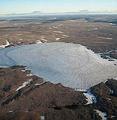 加拿大巴芬(Baffin)島位處極區,長期受冰雪覆蓋,但島上的冰層過去50年來竟已融化大半。科羅拉多大學波德分校近日發表研究指出,溫暖氣溫使得巴芬島北部高原的冰帽縮小,目前面積與1950年相比僅剩一半,並且將在本世紀中完全消失。
加拿大巴芬(Baffin)島位處極區,長期受冰雪覆蓋,但島上的冰層過去50年來竟已融化大半。科羅拉多大學波德分校近日發表研究指出,溫暖氣溫使得巴芬島北部高原的冰帽縮小,目前面積與1950年相比僅剩一半,並且將在本世紀中完全消失。
研究人員分析冰層消融後露出的植物殘跡,透過碳同位素定年法,確認巴芬島冰帽今日的面積是1千6百年來的最小值。科大波德分校極區與高山研究中心(Institute of Arctic and Alpine Research)的地質科學教授米勒(Gifford Miller)表示,「就算氣溫維持現狀,研究結果仍然預測島上的冰帽會在50年內消失。」
巴芬島位於格陵蘭西方,面積約50萬8千平方公里,是世界第五大島,整個島嶼幾乎都在極區以內。
本研究也發現巴芬島冰帽曾經有過兩次快速成長,分別發生在1280年與1450年,冰芯紀錄顯示當時熱帶地區都恰好有大型火山爆發,造成平流層氣溶膠(aerosol)增加。
米勒教授認為,這項意外的發現「是引人注目的證據,代表火山爆發導致小冰期(Little Ice Age)發生」,讓北半球在1250到1850年間處於氣候寒冷的狀態。
研究人員還利用衛星以及1949年以來的空照資料,紀錄巴芬島北部高原冰帽縮減的狀況,這20多個冰帽目前長度都在6公里內,冰雪在土壤上凍結成層,厚度通常不到90公尺。
米勒教授指出,過去1千年來北極地區夏季入射陽光減弱、冰層範圍擴張,一般認為是受到地球自轉軸長週期變化的影響,「巴芬島冰帽近年來反而縮小,因此更顯得異常」。
隨著溫室氣體在地球大氣中累積,北極地區最近數十年氣溫持續攀升。根據科大波德分校的研究,自1991年起,格陵蘭冰層表面溫度已增加約攝氏4度。
本研究發表於地球物理研究通訊(Geophysical Research Letters)期刊,並在28日被選為美國地球物理學會(AGU)重點期刊論文。
Icy Baffin Island in the Canadian Arctic is not half as icy as it was just 50 years ago. Ice caps on the island's northern plateau are 50 percent smaller in area than they were in 1950 due to warming temperatures and are expected to vanish by the middle of the century, according to new research from the University of Colorado at Boulder.
Radiocarbon dating of dead plant material emerging from beneath the receding ice show the Baffin Island ice caps are now smaller in area than at any time in at least the last 1,600 years, said geological sciences Professor Gifford Miller of CU-Boulder's Institute of Arctic and Alpine Research. "Even with no additional warming, our study indicates these ice caps will be gone in 50 years or less," he said.
Located just west of Greenland, the 196,000 square mile Baffin Island is the fifth largest island in the world. Most of it lies above the Arctic Circle.
The study also showed two distinct bursts of Baffin Island ice cap growth beginning about 1280 A.D. and 1450 A.D., each coinciding with ice core records of increases in stratospheric aerosols tied to major tropical volcanic eruptions, Miller said.
The unexpected findings "provide tantalizing evidence that the eruptions were the trigger for the Little Ice Age," a period of Northern Hemisphere cooling that lasted from roughly 1250 to 1850, he said.
The researchers also used satellite data and aerial photos beginning in 1949 to document the shrinkage of more than 20 ice caps on the northern plateau of Baffin Island, which are up to four miles long, generally less than 100 yards thick and frozen to their beds.
The increase of ice extent across the Arctic in recent millennia is thought to be due in large part to decreasing summer solar radiation there as a result of a long-term, cyclic wobble in Earth's axis, said Miller. "This makes the recent ice cap reduction on Baffin Island even more striking," he said.
Temperatures across the Arctic have been rising substantially in recent decades as a result of the build up of greenhouse gases in Earth's atmosphere. Studies by CU-Boulder researchers in Greenland indicate temperatures on the ice sheet have climbed seven degrees Fahrenheit since 1991.
The paper was published online in Geophysical Research Letters and featured in today's edition of the American Geophysical Union journal highlights.
全文及圖片詳見 :ENS





